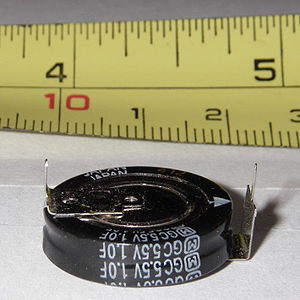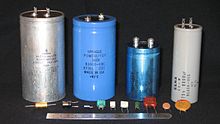| farad | |
|---|---|
 A 1-farad supercapacitor. The scale behind is in inches (top) and centimetres (bottom). A 1-farad supercapacitor. The scale behind is in inches (top) and centimetres (bottom). | |
| General information | |
| Unit system | SI |
| Unit of | capacitance |
| Symbol | F |
| Named after | Michael Faraday |
| Conversions | |
| 1 F in ... | ... is equal to ... |
| SI base units | kg⋅m⋅s⋅A |
The farad (symbol: F) is the unit of electrical capacitance, the ability of a body to store an electrical charge, in the International System of Units (SI), equivalent to 1 coulomb per volt (C/V). It is named after the English physicist Michael Faraday (1791–1867). In SI base units 1 F = 1 kg⋅m⋅s⋅A.
Definition
The capacitance of a capacitor is one farad when one coulomb of charge changes the potential between the plates by one volt. Equally, one farad can be described as the capacitance which stores a one-coulomb charge across a potential difference of one volt.
The relationship between capacitance, charge, and potential difference is linear. For example, if the potential difference across a capacitor is halved, the quantity of charge stored by that capacitor will also be halved.
For most applications, the farad is an impractically large unit of capacitance. Most electrical and electronic applications are covered by the following SI prefixes:
- 1 mF (millifarad, one thousandth (10) of a farad) = 0.001 F = 1000 μF = 1000000000 pF
- 1 μF (microfarad, one millionth (10) of a farad) = 0.000 001 F = 1000 nF = 1000000 pF
- 1 nF (nanofarad, one billionth (10) of a farad) = 0.000 000 001 F = 0.001 μF = 1000 pF
- 1 pF (picofarad, one trillionth (10) of a farad) = 0.000 000 000 001 F = 0.001 nF
Equalities
A farad is a derived unit based on four of the seven base units of the International System of Units: kilogram (kg), metre (m), second (s), and ampere (A).
Expressed in combinations of SI units, the farad is:
where F = farad, s = second, C = coulomb, V = volt, W = watt, J = joule, N = newton, Ω = ohm, Hz = Hertz, S = siemens, H = henry, A = ampere.
History
The term "farad" was originally coined by Latimer Clark and Charles Bright in 1861, in honor of Michael Faraday, for a unit of quantity of charge, and by 1873, the farad had become a unit of capacitance. In 1881, at the International Congress of Electricians in Paris, the name farad was officially used for the unit of electrical capacitance.
Explanation

A capacitor generally consists of two conducting surfaces, frequently referred to as plates, separated by an insulating layer usually referred to as a dielectric. The original capacitor was the Leyden jar developed in the 18th century. It is the accumulation of electric charge on the plates that results in capacitance. Modern capacitors are constructed using a range of manufacturing techniques and materials to provide the extraordinarily wide range of capacitance values used in electronics applications from femtofarads to farads, with maximum-voltage ratings ranging from a few volts to several kilovolts.
Values of capacitors are usually specified in terms of SI prefixes of farads (F), microfarads (μF), nanofarads (nF) and picofarads (pF). The millifarad (mF) is rarely used in practice; a capacitance of 4.7 mF (0.0047 F), for example, is instead written as 4700 μF. The nanofarad (nF) is used more often in Europe than in the United States. The size of commercially available capacitors ranges from around 0.1 pF to 5000F (5 kF) supercapacitors. Parasitic capacitance in high-performance integrated circuits can be measured in femtofarads (1 fF = 0.001 pF = 10 F), while high-performance test equipment can detect changes in capacitance on the order of tens of attofarads (1 aF = 10 F).
A value of 0.1 pF is about the smallest available in capacitors for general use in electronic design, since smaller ones would be dominated by the parasitic capacitances of other components, wiring or printed circuit boards. Capacitance values of 1 pF or lower can be achieved by twisting two short lengths of insulated wire together.
The capacitance of the Earth's ionosphere with respect to the ground is calculated to be about 1 F.
Informal and deprecated terminology
The picofarad (pF) is sometimes colloquially pronounced as "puff" or "pic", as in "a ten-puff capacitor". Similarly, "mic" (pronounced "mike") is sometimes used informally to signify microfarads.
Nonstandard abbreviations were and are often used. Farad has been abbreviated "f", "fd", and "Fd". For the prefix "micro-", when the Greek small letter "μ" or the legacy micro sign "μ" is not available (as on typewriters) or inconvenient to enter, it is often substituted with the similar-appearing "u" or "U", with little risk of confusion. It was also substituted with the similar-sounding "M" or "m", which can be confusing because M officially stands for 1,000,000, and m preferably stands for 1/1000. In texts prior to 1960, and on capacitor packages until more recently, "microfarad(s)" was abbreviated "mf" or "MFD" rather than the modern "μF". A 1940 Radio Shack catalog listed every capacitor's rating in "Mfd.", from 0.000005 Mfd. (5 pF) to 50 Mfd. (50 μF).
"Micromicrofarad" or "micro-microfarad" is an obsolete unit found in some older texts and labels, contains a nonstandard metric double prefix. It is exactly equivalent to a picofarad (pF). It is abbreviated μμF, uuF, or (confusingly) "mmf", "MMF", or "MMFD".
Summary of obsolete or deprecated capacitance units or abbreviations: (upper/lower case variations are not shown)
- μF (microfarad) = mf, mfd, uf
- pF (picofarad) = mmf, mmfd, pfd, μμF
U+3332 ㌲ SQUARE HUARADDO is a square version of ファラッド (faraddo, the Japanese word for "farad") intended for Japanese vertical text. It is included in Unicode for compatibility with earlier character sets.
Related concepts
The reciprocal of capacitance is called electrical elastance, the (non-standard, non-SI) unit of which is the daraf.
CGS units
The abfarad (abbreviated abF) is an obsolete CGS unit of capacitance, which corresponds to 10 farads (1 gigafarad, GF).
The statfarad (abbreviated statF) is a rarely used CGS unit equivalent to the capacitance of a capacitor with a charge of 1 statcoulomb across a potential difference of 1 statvolt. It is 1/(10 c) farad, approximately 1.1126 picofarads. More commonly, the centimeter (cm) is used, which is equal to the statfarad.
Notes
- ^ The International System of Units (SI) (8th ed.). Bureau International des Poids et Mesures (International Committee for Weights and Measures). 2006. p. 144.
- "farad | Definition, Symbol, & Facts | Britannica". www.britannica.com. Retrieved 2022-07-25.
- Peter M B Walker, ed. (1995). Dictionary of Science and Technology. Larousse. ISBN 0752300105.
- The International System of Units (SI) (9th ed.). Bureau International des Poids et Mesures. 2019. p. 138.
-
As names for units of various electrical quantities, Bright and Clark suggested "ohma" for voltage, "farad" for charge, "galvat" for current, and "volt" for resistance. See:
- Latimer Clark and Sir Charles Bright (1861) "On the formation of standards of electrical quantity and resistance," Report of the Thirty-first Meeting of the British Association for the Advancement of Science (Manchester, England: September 1861), section: Mathematics and Physics, pp. 37-38.
- Latimer Clark and Sir Charles Bright (November 9, 1861) "Measurement of electrical quantities and resistance," The Electrician, 1 (1): 3–4.
- Sir W. Thomson, etc. (1873) "First report of the Committee for the Selection and Nomenclature of Dynamical and Electrical Units," Report of the 43rd Meeting of the British Association for the Advancement of Science (Bradford, September 1873), pp. 222-225. From p. 223: "The "ohm," as represented by the original standard coil, is approximately 10 C.G.S. units of resistance: the "volt" is approximately 10 C.G.S. units of electromotive force: and the "farad" is approximately 1/10 of the C.G.S. unit of capacity."
- (Anon.) (September 24, 1881) "The Electrical Congress," The Electrician, 7: 297. From p. 297: "7. The name farad will be given to the capacity defined by the condition that a coulomb in a farad gives a volt."
- Tunbridge, Paul (1992). Lord Kelvin: his influence on electrical measurements and units. London: Peregrinus. pp. 26, 39–40. ISBN 9780863412370. Retrieved 5 May 2015.
- Braga, Newton C. (2002). Robotics, Mechatronics, and Artificial Intelligence. Newnes. p. 21. ISBN 0-7506-7389-3. Retrieved 2008-09-17.
Common measurement units are the microfarad (μF), representing 0.000,001 F; the nanofarad (nF), representing 0.000,000,001 F; and the picofarad (pF), representing 0.000,000,000,001 F.
- Platt, Charles (2009). Make: Electronics: Learning Through Discovery. O'Reilly Media. p. 61. ISBN 9781449388799. Retrieved 2014-07-22.
Nanofarads are also used, more often in Europe than in the United States.
- Gregorian, Roubik (1976). Analog MOS Integrated Circuits for Signal Processing. John Wiley & Sons. p. 78.
- Pease, Bob (2 September 1993). "What's All This Femtoampere Stuff, Anyhow?". Electronic Design. Retrieved 2013-03-09.
- Pease, Bob (1 December 2006). "What's All This Best Stuff, Anyhow?". Electronic Design. Retrieved 2013-03-09.
- Williams, L. L. (January 1999). "Electrical Properties of the Fair-Weather Atmosphere and the Possibility of Observable Discharge on Moving Objects" (PDF). Archived from the original (PDF) on 2016-12-21. Retrieved 2012-08-13.
- "Puff". Wolfram Research. Retrieved 2009-06-09.
- "1940 Radio Shack Catalog - Page 54 - Condensers". radioshackcatalogs.com. Archived from the original on 11 July 2017. Retrieved 11 July 2017.
- "Daraf". Webster's Online Dictionary. Archived from the original on 2011-10-04. Retrieved 2009-06-19.
- Graf, Rudolf F. (1999). Modern Dictionary of Electronics. Newnes. p. 1. ISBN 9780080511986. Retrieved 2016-04-15.
External links
| SI units | |
|---|---|
| Base units | |
| Derived units with special names | |
| Other accepted units | |
| See also | |
| Michael Faraday | |
|---|---|
| Physics | |
| Lectures | |
| Related | |
